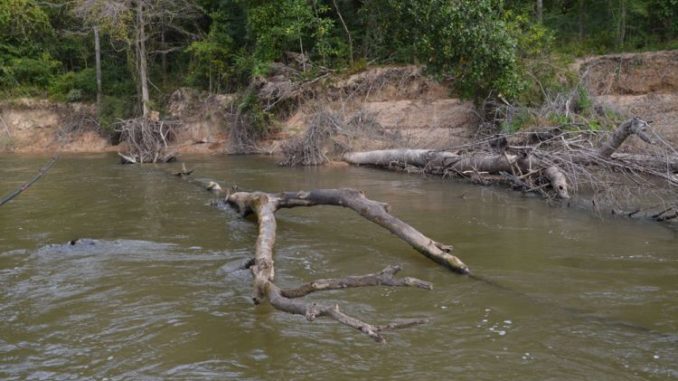
Todd McElveen and Steven Schilling are hooked on the Bogue Chitto River. McElveen called it “one of the prettiest rivers you want to go on.” Schilling said, “It’s like a hidden gem.”
The river roughly bisects their home parish and all of it is fishable, although Schilling admitted, “It’s a lot of trouble to fish.”
It changes character as it winds its way southward. At the state line, McElveen described it as “small enough to throw a rock across,” and north of the line, in Mississippi, it is even narrower and deeper, he said.
From the state line to Franklinton it is uniformly shallow (the bottom is visible in most places), crooked and littered with logs. From Franklinton southward it grows gradually but steadily deeper.
Even there, Schilling doesn’t recommend running a propeller-driven outboard on a flatboat hull. “A tunnel boat in skilled hands, powered by a 25 horsepower motor or less is usable, but you still really need a jet drive motor.”
Lacking a jet drive, the men recommend using a flatboat, preferably equipped with a trolling motor, to float from highway bridge to highway bridge. Ignoring those in Mississippi, five bridges span the river and allow access: Highway 438 at Warnerton, Highway 38 at Clifton, Highway 16 at Franklinton, Highway 437 at Enon and Highway 21 in Sun (in St. Tammany Parish).
McElveen described a typical bridge operation.
“Two guys drive two trucks to the lower bridge, leave one, and then take the truck with boat to the upper bridge to launch the boat. They fish down to the lower bridge, load the boat in the truck, and then drive to the upper bridge to get that truck.”
Another option for people who don’t have a flatboat or who have only one vehicle is to use the services of Rocky Bottom Tubing and Canoeing (985-515-1477). Located conveniently in Bogue Chitto State Park, owner Len Bickham rents out canoes and fishing kayaks.
He will ferry fishermen, using his craft or their own kayaks, to put-ins 3 miles, 6 miles or 9 miles upriver, allowing fishermen to fish at their own pace back to the park where their vehicle is parked. The 6-mile trip takes four to six hours.
Between April 1 and October 1, a staff member is present at the park daily from 9 a.m. until the last person is off the river. The rest of the year, Bickham recommends an advance call for arrangements.
Although some largemouth bass are caught in the slower currents of deeper pools, most of the catch is made up of spotted bass.
“The average Kentucky (a nickname for spotted bass) is a pound or less,” noted Schilling. “But a 1-pounder pulls like a 3 ½- or 4-pound largemouth.”
“I don’t care how big they are,” said McElveen airily. “I just love to catch them.”
“Even as big as a butter bean,” laughed Schilling. “I eat butter beans.”
